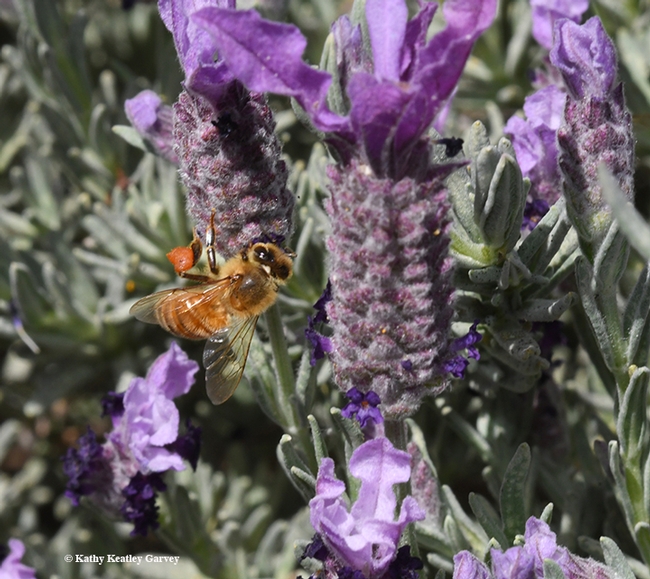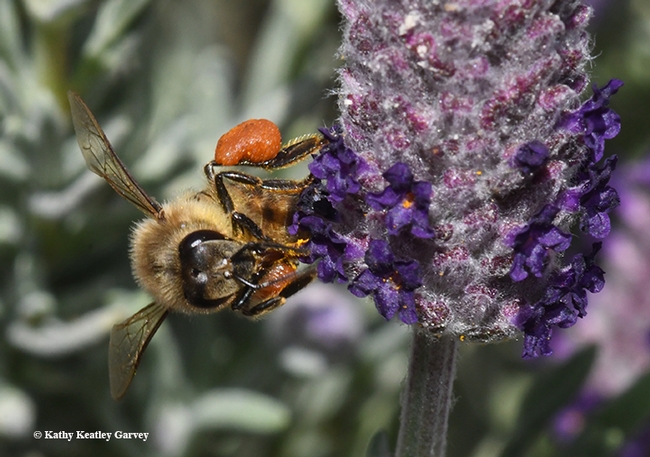
How about "getting the red in?"
Have you ever seen a honey bee packing white, pink, blue, lavender, yellow, orange or red pollen? Have you ever seen the colorful diversity of pollen grains gracing their hives? Stunning.
Take red. It's a warning color in nature--think lady beetles, aka ladybugs. Predators know they don't taste good so they learn to leave them alone.
A chunk of red pollen on a honey bee, however, looks like a sun-ripened strawberry.
Lately we've been seeing honey bees with red pollen foraging on our Spanish lavender, Lavandula stoechas. Problem is, lavender yields a pale whitish pollen, not red. Last summer, the red came from the adjacent rock purslane (Calandrinia grandiflora). It's not blooming now, however, so, they're drawing that brilliant red pollen elsewhere. And stopping by the Spanish lavender for nectar, their flight fuel.
Robbin Thorp, distinguished emeritus professor of entomology at UC Davis, says "I have not observed honey bees collecting pollen from lavender, but have seen them with pollen loads from other flowers stopping for a sip of nectar...especially honey bees that have been foraging on plants that do not produce nectar like California poppies, and lupines."
"English lavender, rosemary, thyme, oregano, and most other members of the mint family have pale pollen rarely collected by honey bees, but these garden herbs are all great nectar resources," he says. "It is common to see honey bees on these plants with the wrong color pollen as they forage the herbs for nectar."
We're waiting for the cilantro to bloom. Then the bees will "be in the pink," so to speak. Pink pollen.
Meanwhile, if you want to learn more about honey bees, three UC Davis-affiliated events await you.
Saturday, May 6: The inaugural California Honey Festival, an event coordinated by the UC Davis Honey and Pollination Center, will be held within a four-block area in downtown Woodland. Free and open to the public, it will include presentations, music, mead speakeasies, honey-tasting, vendors, bee friendly gardening, and a kids' zone.
Sunday, May 7: The third annual UC Davis Bee Symposium, sponsored by the Honey and Pollination Center and the UC Davis Department of Entomology and Nematology, will take place in the UC Davis Conference Center. Keynote speaker is Steve Sheppard, professor and chair of the Department of Entomology, Washington State University, Pullman, Wash. Registration is underway.
Tuesday through Friday, Sept. 5-8: The Western Apicultural Society, founded at UC Davis, will return to UC Davis for its 40th annual meeting. It was co-founded by Norm Gary (it was his brainchild), Eric Mussen and Becky Westerdahl at what is now the Harry H. Laidlaw Jr. Honey Bee Research Facility, UC Davis. Mussen, now Extension apiculturist emeritus, is serving his sixth term as president since 1984. WAS serves the educational needs of beekeepers from 13 states, plus parts of Canada.
Attached Images:

